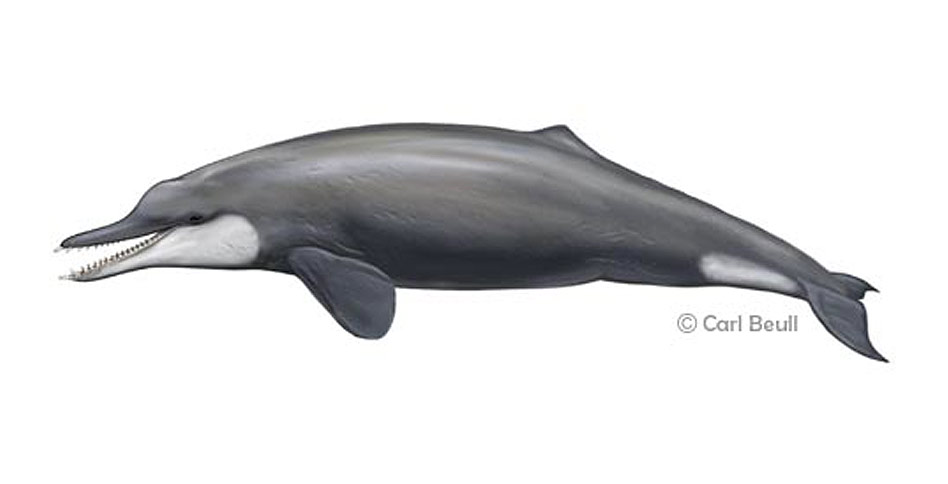
Waipatia Maerewhenua
Age: 24-26 million years ago, Oligocene Epoch.
Range: The only known specimen of Waipatia is from New Zealand, indicating this early toothed whale inhabited the southwest Pacific Ocean.
Size: Although only the skull, lower jaws, and first two vertebrae of the neck are known, the size of the skull (two feet long) suggests that Waipatia may have measured around 10-12 feet in length.
Anatomy: Due to its long snout, Waipatia would have looked relatively similar to modern river dolphins; however, Waipatia differs from modern toothed whales in several important ways. Most obviously, Waipatia retains “heterodont” teeth, where teeth in different positions of the mouth are of different shapes and sizes. The most forwardly positioned teeth of Waipatia are long, conical, and project forward, whereas the cheek teeth are triangular with many serration-like cusps. Additionally, Waipatia has a higher tooth count than earlier archaeocetes. The top of the skull and the facial bones adjacent to the blowhole are not positioned as close to the back of the skull as those in some modern toothed whales, indicating that Waipatia had a more limited degree of “telescoping” of the facial bones over the bones of the braincase. Telescoping of the skull is named after the collapsible telescopes used by some mariners. As with the bones of the skull, the front tubes of the mariner’s telescope slide over the smaller tubes toward the back end of the telescope.
Locomotion: Little of the skeleton of Waipatia is known, and it is difficult to assess its locomotion without these parts of the skeleton.
Sensory Abilities: The lower jaw has a very large ‘foramen’ (hole) indicating that Waipatia had a mandibular fat pad like basilosaurid archaeocetes and modern toothed whales. This fat pad channels sound to the ear bones and is a specialization for underwater hearing. The top of the skull of Waipatia is slightly asymmetrical, although not to the degree observed in modern toothed whales. More importantly the face is concave, suggesting the presence of a melon in life. The melon is a component of the anatomical complex that allows modern odontocetes to produce high frequency sounds used in echolocation. Odontocete echolocation is much like sonar; the cetacean interprets the echoes of vocalizations to create an audio “picture” of the environment. We hypothesize that Waipatia had the capability to hear these high frequency sounds upon their return. In addition, other fossil, toothed whales of similar evolutionary grade have a bony anatomy of the cochlea, the coiled organ of hearing in the inner ear bone, that is indicative of high frequency hearing.
Diet: The long snout and relatively large space for the temporalis muscles suggest that Waipatia rapidly snapped its jaws together. Although the cheek teeth of Waipatia are generally similar in shape to those of archaeocete cetaceans, they are much smaller relative to the rest of the jaw, did not interlock, and lack the large wear facets produced by shearing action. This suggests that the teeth of Waipatia were used to capture and grip its prey prior to swallowing it whole, similar to the tooth function in many modern whales and dolphins. This system contrasts with some large archaeocetes like Basilosaurus and Dorudon that may have sliced prey items up into smaller pieces before swallowing. The feeding features of Waipatia, in concert with the inferred echolocation capabilities of this animal, suggest that Waipatia fed on small, active prey like fish and possibly squid. Although the forward pointing, elongate incisors were initially suggested to have had a social display function, other extinct cetaceans (Squalodon, Janjucetus) and marine reptiles (plesiosaurs) have developed similar teeth at the front of the snout, and they may have functioned as a ‘fish trap’.
Author: Summary written by Robert Boessenecker
References Consulted: Fordyce, R.E. 1994. Waipatia maerewhenua, New Genus and New Species, an Archaic Late Oligocene Dolphin from New Zealand. Pp. 147-176 in A. Berta and T.A. Deméré (eds.), 1994, Contributions in Marine Mammal Paleontology Honoring Frank Whitmore, Jr. Proceedings of the San Diego Society of Natural History 29.
Luo, Z, and Eastman, ER. 1995. Petrosal and inner ear of a squalodontoid whale: implications for evolution of hearing in odontocetes. J. Verter Paleontol 15:431-442.